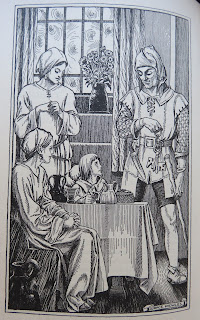The author, Enid Blyton (born 11 August 1897), grew up in London. She finished school in 1915 and began training as a primary school teacher in 1916. One of her brothers, Hanly, fought in the First World War with the Machine Gun Corps and survived. She qualified in 1918 and began writing in 1920. Her first book, a collection of poems, was published in 1922. She married in 1924 and soon became prolific in writing plays and story books. By the 1940s she could see the value of writing a whole series of books featuring the same characters, the Famous Five, for example, first appearing in the same year as this book. The success of the vast majority of her books was enhanced by the use of gifted illustrators, such as Eileen Roper and Horace Knowles, whose drawings appear in this book.
Beyond its moral emphasis, this book is significant for its teaching about fear and courage to children living through the violence of the Second World War. At an early stage in the journey, one of the adults, called Mr Fearful, refuses to cross the River Trouble at the Ford of Determination:
“He wept bitterly as he saw the others going off towards the hill in the distance. But he was much too afraid to go across the river by himself.”
Later another adult, Dick Cowardly, flees at the sight of a group of soldiers guarding the road ahead of them:
“I daren't stay here to face those soldiers. We shall be cut to pieces! We shall be taken prisoner!... I want to go back home. I daren't face any more dangers. Better to be safe in the City of Turmoil with this load on my shoulders than cut to pieces by fierce soldiers!”
The soldiers are in fact guarding the House of Peace and Peter realises Dick Cowardly’s mistake:
“Poor Dick Cowardly. He could easily have stayed and gone with us. If only he had had a little more courage and had kept with us.”
 On the other hand, the children meet a character called Courage, “a stout, smiling youth”, who was “big and strong” and “his mouth was determined.” He helps them to rescue their travelling companions who have been imprisoned in the dungeons of the Castle of Desolation. The young readers are shown that virtues, such as courage, honesty, mercy, patience and truth, led the children from turmoil through many dangers to a place of contentment. This was, no doubt, important for building character in children growing up during the war.
On the other hand, the children meet a character called Courage, “a stout, smiling youth”, who was “big and strong” and “his mouth was determined.” He helps them to rescue their travelling companions who have been imprisoned in the dungeons of the Castle of Desolation. The young readers are shown that virtues, such as courage, honesty, mercy, patience and truth, led the children from turmoil through many dangers to a place of contentment. This was, no doubt, important for building character in children growing up during the war.





